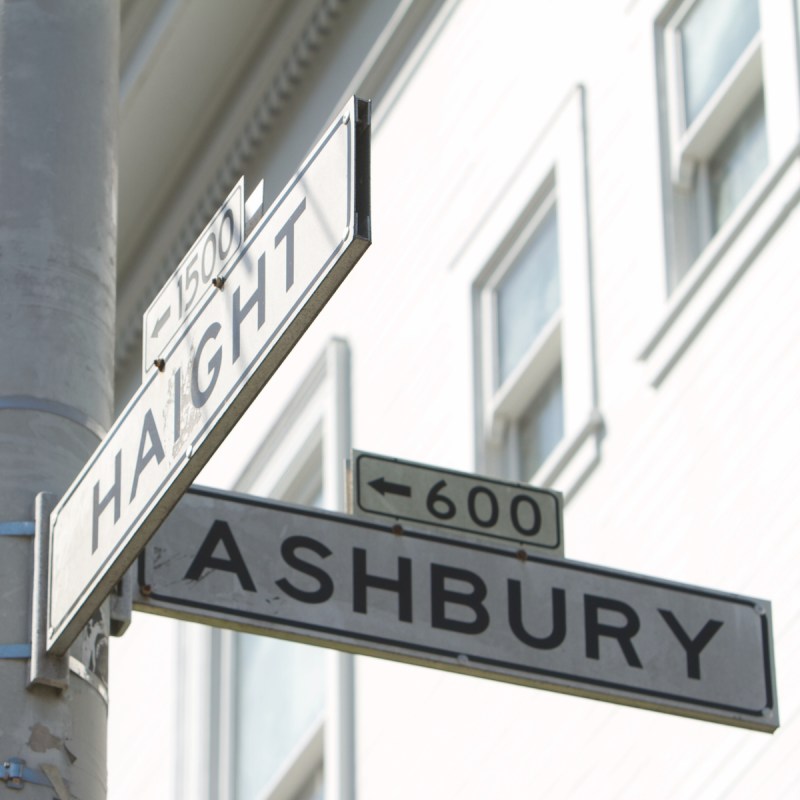
I stayed with an Airbnb host in Philadelphia when traveling in the states. Her traditional brownstone featured stunning paintings and objets d’art. Learning I was bound for California, she told me stories of how she had hitchhiked to San Francisco as a teen runaway in the 1960s. “Those months with the counterculture changed my life,” she said. “I returned home and devoted my life to art.”
Videos by TravelAwaits
She wasn’t alone in her life-changing quest. An estimated 100,000 youngsters converged on San Francisco for the 1967 Summer of Love — the largest youth migration in American history.
They came for hippy culture: mind-expanding drugs, anti-war sentiment, music, and free love. The epicenter of hippiedom was Haight-Ashbury, a San Francisco district near Golden Gate Park.

Why Haight-Ashbury?
During the World War II housing shortage, Haight-Ashbury’s multi-story homes were carved-up as apartments for workers. Some became boarding houses. Low rents and Edwardian architecture, with stunning turrets and bay windows, attracted the beatniks of the 1950s and 1960s hippies.
Rock ‘N Roll Houses
They say, if you remember the ‘60s, you weren’t there. But history tells us the rockstars were in the Haight. Their homes are now shrines to the time. Pose outside, but as private residencies, don’t go knocking.
1. Grateful Dead’s House
The band most associated with the hippie heydays was The Grateful Dead. From 1966–68, Jerry Garcia and other members lived at 710 Ashbury. Envisage the wild parties and jam sessions. “The Dead” rocked on for another 30 years, giving free concerts attracting up to 80,000 a pop. A key to their longevity was the obsessive loyalty of their fans, known as Deadheads. Thousands followed The Dead around the country. Outside their original home, note the dedicated sidewalk art, and you may meet some Deadheads who make this pilgrimage.
In the ‘60s, The Dead’s front door was open to anyone except the police. According to the documentary, Janis: Little Girl Blue, Joplin dated Ron “Pigpen” McKernan, The Dead’s original keyboard player. Her loud love-making kept the household awake. Given her incredible voice, small wonder.
2. Hell’s Angels Headquarters
The Hells Angels lived across at 715, deafening the neighborhood when they revved their “hawgs.” When the police busted 11 people at The Dead’s house for drugs, Garcia was at the Hell’s Angels’ house. I guess he felt safe there. Hunter S. Thompson infiltrated the outlaw motorcycle gang to write Hell’s Angels (1967). He didn’t live in “Hashbury,” his name for the Haight, but he was within punching distance.

3. Jimi Hendrix’s Red House
Red House, 1524A Haight Street, is a few doors from the intersection. Whether Hendrix lived here is debated, but it’s painted red, as in Hendrix’s song Red House, and features Hendrix murals on the sides.
4. Janis Joplin’s Homes
Janis Joplin’s driver’s license listed her at 122 Lyon Street in 1967. She also lived in a flat at 635 Ashbury. Today, it’s a beautiful pink-painted lady. The legendary singer lived hard and died young, a member of the 27 Club — celebrities who died at 27 from drugs or alcohol. The club included Hendrix and Joplin’s Grateful Dead boyfriend, Pigpen.
The Darker Side Of The ’60s
5. Charles Manson’s Family Home
Charles Manson lived at 636 Cole Street, hustling LSD, dropping acid at Grateful Dead shows, bedding young girls, and becoming a self-proclaimed guru during 1967’s Summer of Love. He then took his followers to LA, where the group committed nine murders in July and August of 1969. True crime lovers may enjoy the True Crime Walking Tour.
6. Patty Hearst Hideout
The Symbionese Liberation Army kidnapped heiress Patty Hearst from her apartment in Berkeley in 1974. They demanded Hearst’s family establish a multi-million-dollar food bank for the impoverished citizens of San Francisco. One of the houses they held her captive in was 1235 Masonic Avenue. Given that Haight was an outpost for the counterculture, her captors easily blended in.

Parks
Haight-Ashbury borders parks that became music and protest venues during the Summer of Love.
7. Panhandle Park
The Panhandle is eight blocks long and one block wide, appearing on a map of the Haight like a handle to the more-famous Golden Gate Park. The Panhandle was home to free Jefferson Airplane, Jimi Hendrix, and The Dead concerts. And it was a protest site when the San Francisco Board of Supervisors criminalized psychedelic drugs.
8. Golden Gate Park
The hippies also spilled into Golden Gate Park, which bounds Haight-Ashbury to the west. A grassy knoll became known as Hippy Hill. And an elm tree where Janis Joplin liked to sit and strum is now called the “Janis Joplin Tree.”
Activists organized the Human Be-In on January 14, 1967, where Timothy Leary voiced a slogan for the generation: “Turn on, tune in, drop out.” Today, “420 in the Park” is held annually on April 20.
Or picnic any day. Supplies are available from Whole Foods nearby, a chain that started as a hippy spin-off. Bring a set of headphones and listen to classics from 1967 — a different way to tune in and drop out.

Murals
Murals cover Haight’s streetscape. Even a Banksy has popped up. Many mimic the ‘60s but are recent additions.
9. Evolutionary Rainbow
An exception is Evolutionary Rainbow by Yana Zegri. She created her rainbow in 1967 and it has watched over Haight and Cole ever since. Street murals come and go, but Zegri committed to maintaining hers. When she died in 2019, the neighborhood adorned her mural with flowers.
10. Garcia, Joplin, And Hendrix
The holy trinity of rock legends features on many Haight murals. An example is Dead Rockstars by Satyr1 in the parking lot by Shrader Street.

Shopping
Most businesses catering to the hippies closed by the end of 1969, replaced with shops selling the hippy dream to tourists. But as the Haight remains synonymous with freedom of expression, political activism, and unconventional lifestyles, there’s still a certain edginess to these newcomers.
11. Amoeba Music
At the corner of Haight and Stanyan Streets, Amoeba Music stocks hundreds of thousands of music and movie titles, vinyl records, CDs, DVDs, and vintage posters. Another bonus is Amoeba’s emphasis on San Francisco bands with a sprawling Grateful Dead section. The store offers free concerts.
12. Love On Haight
Tie-dye is a marker of individuality, as each piece is unique. American youth picked up on the trend when Joplin, Hendrix, and Garcia started wearing tie-dye. This tie-dye company partners with over 200 artists.
13. Cold Steel America
This is a cool shop to photograph and a well-respected professional tattoo and piercing studio.
14. Piedmont Boutique
Synonymous with the Haight is a pair of fishnet-stockinged legs protruding from a window. Piedmont Boutique is known for its sparkling drag queen regalia and massive collection of colorful earrings and accessories.
15. Decades Of Fashion
This beautiful vintage clothing shop is like a museum. Owner Cicely Hansen has been collecting for over 50 years and the store carries clothing from the mid-1800s to the late 1980s.
16. Loved To Death
Check out Loved To Death to find one-of-a-kind decorative oddities, rare goth treasures, and Victorian curiosities.
17. Haight Street Art Center
When you bump into a giant bronze bunny outside 215 Haight Street, you’ve arrived! Inside, find historic rock-concert posters. The free exhibitions connect generations through visual art and storytelling rooted in San Francisco counterculture. The gallery shop is a must.
Bars
There’s plenty to drink in the Haight besides wheat-grass juice.
18. Magnolia Brewing
In 1964, it was the Drugstore Cafe. In the late ‘60s, it was named Magnolia Thunderpussy’s after its burlesque queen owner. Her famous dish was “The Montana Banana,” an unsplit banana standing erect between two scoops of ice cream. Today, 1398 Haight Street is Magnolia Brewing, with beer brewed on site. The Montana Banana has gone; instead, order a Hippie Hill Bowl with tri-color quinoa washed down with an Old Thunderpussy’s Barley Wine.
19. Zam Zam
Zam Zam has been around since 1941. The original owner would chuck out hipsters and hippies. Today, there’s a friendlier vibe and it’s worth seeing the art-deco interior with its original curved bar, vintage cash register, and jukebox.
Related Reading:
